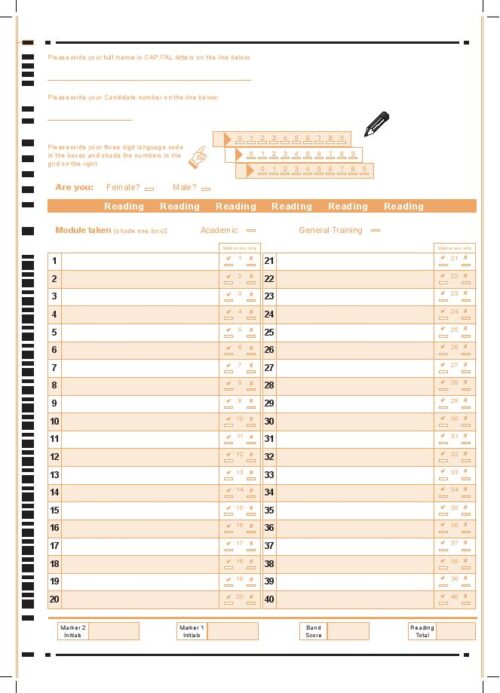IELTS is an English proficiency test which one has to take before migrating to English-speaking countries.
The test examines the four aspects of communication: Listening, Reading, Writing, and Speaking.
Anybody with a good command over the English language can be expected to score well in IELTS, but without knowing the IELTS test format it is an arduous task. This is because IELTS not only tests your knowledge of English but also other academic skills like note taking, speed reading, critical thinking, and prompt response.
| Disclaimer |
|---|
| This article focuses on the paper-based IELTS test. There is also the computer-based IELTS test. Nonetheless, IELTS exam format is exactly the same for both. The only difference is that instead of writing your answers on a paper, you type them into a computer software. The Speaking test is given by a human person in physical face-to-face interview, even in the computer-based test. |
What happens on Test Day?
Almost everywhere in the world, IELTS is a two-day test. On one day, you take the Listening, Reading and Writing tests. Speaking test happens on a separate day, usually a day or two before or after the other tests.
You are invited to test location, by text as well as by email, a couple of hours before the test begins. You need to carry your identification document – your passport – and nothing else.
The British Council or the IDP Education staff, who are at the test center, verify your document and take your biometric data to ensure your identity. Then, you are allowed into the test hall. It will be a large room, with individual tables and chairs for each test taker.
The tables and chairs are arranged in rows and columns with huge gaps in between. Your table would have a headset for the Listening test, pencils, pens, an eraser, and a pencil sharpener (some test centers may not provide these, so make sure before you go.)
You write your entire test with a pencil.
You are not allowed to take anything with you, except for looking glasses. Even jewellery or wrist watches are prohibited.
The exam hall has two clocks: one shows the current time and another displays the countdown of time remaining.
There are several invigilators in the exam hall to help the test takers and to make sure nobody cheats.
The exam format will be explained before the test begins. There is no break between the Listening and the Reading or the Reading and the Writing test.
You can raise your hand if you need a toilet break or have any other query, and someone will come to your desk to help you.
IELTS Academic Format: Writing
The test begins with the Writing section. Writing is a one-hour test, where two questions are asked.
Even though IELTS test format dictates that you to complete the first question in 20 minutes and the second in 40 minutes, you are allowed to allocate the time as per your wish. The invigilators in the exam will recommend but they will not force you to abandon the first question after 20 minutes.
Task 1
The first question will provide you with an image, which you have to describe using at least 150 words.
The image could be a line graph, a bar diagram, pie charts, a process diagram, or maps.
Your answer should contain an introduction to the image as well as description of different aspects of the image. You also need to write a summary of the information.
Task 2
In the second question, you need to write an argumentative essay on a typical problem faced by the world, such as climate change or inequality. Or, you could be asked to justify or refute an common opinion held by people.
Your answer should be composed of at least 250 words.
You should write several paragraphs introducing the topic, presenting arguments and evidences, and reaching a conclusion.
If you are interested in a detailed breakdown of the evaluation of the Writing test, click here »
IELTS Test Format: Listening
The second test of the IELTS exam is the Listening test. It is around 40 minutes long.
Everybody in the exam hall puts on his or her headphone and a sample audio is played to make sure the devices are working.
Your headphone will have the control for increasing or decreasing the volume, but you cannot control pause or play. All the test takers on a particular day listen to the same audio at the same time.
There are 4 different audio recordings, each with 10 questions. So, in total there are 40 questions.
Time (usually 30 seconds) is given before each recording starts to study the questions, and again after each recording ends to recheck the answers.
The audio is played only once.
While listening, you write your answers in the question paper itself. At the end of the test, you will be given 10 minutes time to transfer your answer into the answer sheet.
The answer sheet has boxes numbered 1 to 40. You have to write the answers to the 40 questions in the corresponding boxes.

Part 1
The first audio recording will be a conversation between two people in a social situation. For example, it could be a customer and a shopkeeper, or just two friends chatting.
The audio recording is always broken into two parts, which means after some questions there will be a pause, allowing time for you to prepare for the upcoming questions, before the remaining part is played.
The questions are usually form fill-up questions. Based on what the people in the audio talk about, you may need to fill in names, addresses, and telephone numbers in the question paper.
Multiple choice questions, though rare, could also be asked in Part 1.
Part 2
The second audio recording is always a monologue in a social situation. This means, you will listen to a speech or a talk given by a single person about their own lives, about their society, about their work, or some news.
Sometimes you may hear more than one speaker in Part 2. Nevertheless, the answers to the questions will come from just one speaker.
This audio recording is also broken into two parts. For instance, there may be break after question number 16 to allow you time to read questions 17 to 20.
Part 2 may have fill in the blanks, multiple choice, matching, or diagram labeling questions.
Part 3
Part 3, I believe, is the most difficult section in the Listening test. This is due to the fact that there are two or three speakers, who are having a discussion about an academic topic like planning university assignments or project work.
You need to recognize the speakers by the voice as well as their attitude and tone. Most answers are not stated in a straightforward manner, but by the use of idioms and colloquial expressions.
This audio recording is also broken into two parts.
Multiple choice questions are the most common types of questions in Part 3.
Part 4
In this section, you will hear a speech or a talk or a university lecture about an academic topic.
Just imagine if you randomly walk into a classroom in a university. The professor could be explaining about any topic that is taught in universities. In the same manner, the audio in the exam could be a lecture on Microbiology or Astrophysics or Political Science or History.
In Part 4, the entire audio is played without any breaks. That mean, all 10 questions, from question number 31 to 40, have to be answered at once.
Note completion is the most common question type in Part 4.
IELTS Exam Format: Reading
Immediately after the Listening test, the Reading test is held.
It is a one-hour test, where you get a question booklet with three long passages and 40 accompanying questions.
Each passage will be anywhere between 400 and 900 words long. Passage 1 will the easiest in terms of language difficulty, whereas Passage 3 will be the most difficult.
The passages could be about any topic of popular interest. Cambridge Assessment English sets the questions based on scientific, historical, or social articles published in international newspapers and magazines.
Rather than overall meaning of the passages, the questions test your understanding of specific information within the text.
Unlike the Listening test, you have to write the answers into the answer sheet within the one hour; you will not get 10 minutes extra.
Here also, the answer sheet has boxes numbered 1 to 40. You have to write the answers to the 40 questions in the corresponding boxes.

There are 10 types of question which you might get in the IELTS Reading test.
| Question type | Description |
|---|---|
| Short answer questions | A who, what, where, when type question with a short answer usually between one and three words. |
| Matching headings | Selecting the best heading to each paragraph of the text from a list of options. |
| Multiple choice questions | Questions where you have to select one or more right answers from the given options. |
| Locating information | You need to figure out which paragraph of the text contains the details presented in the question. |
| Diagram labeling | Labeling different sections of a diagram based on textual information. |
| Classification/matching | Classifying information into different categories or matching the information to the correct category. |
| Fill in the blanks | Completing the gaps in the question, which could be a paragraph, a table, a flow chart, or a summary, by finding the correct words in the passage or from a list of options. |
| Global multiple choice question | Finding out the central theme of a passage or finding the best heading for the passage. |
| True, False, Not Given | Determining whether the information given are accurate or not based on information in the text. Some information may be absent from the text, in which case the answer will be Not Given. |
| Yes, No, Not Given | Determining whether the opinions given are held by the author or not. Some information may be absent from the text, in which case the answer will be Not Given. |
Read also:
IELTS Test Format: Speaking
The Speaking test is held for between 11 to 15 minutes.
You enter into a room and sit with an examiner who will ask you several questions and they will also record your answer for separate evaluation.
You are judged on your ability to hold conversation as well as your prowess to use a wide range of vocabulary and grammatical structures.
It is a misconception that your body language, personality, or opinions are evaluated. Only the words you speak and their accuracy matter.
There are three parts of the Speaking test.
Part 1
In the first part, you are asked personal questions about your home, family, friends, and interests.
The examiner will introduce a topic and start asking you several personal questions on that topic. For example, a topic could be “music” and a question could be “What is your favorite song?”
The questions are set beforehand and will not change depending on your answers. But sometimes the examiners may ask you to elaborate.
You need to provide short answers to these questions, usually just two or three sentences.
This part takes about 5 minutes.
Part 2
Part 2 entails giving a short speech on a personal matter.
The examiner will provide you with a cue card (a question paper) which has a topic and four short questions. For instance, the topic could be “your most memorable holiday” and questions could be “where was it, when was it, what did you do, and why do you remember it?”
You are given one minute to prepare your response. You can even write down the points that you want to talk about.
After one-minute preparation time, you need to give a continuous speech of between one and two minutes.
The examiner will not ask you any questions, except sometimes at the end of your speech if something needs clarification.
Part 3
Part 3 is just like Part 1: you will be asked several questions for which you need to provide short answers.
The difference is that this time you will not be asked personal questions but general questions about society and the world.
For example, you could be asked about the influence of media on children, the effects of pollution, or the importance of sports.
This part lasts for roughly five minutes.
You may also like:



Very nice